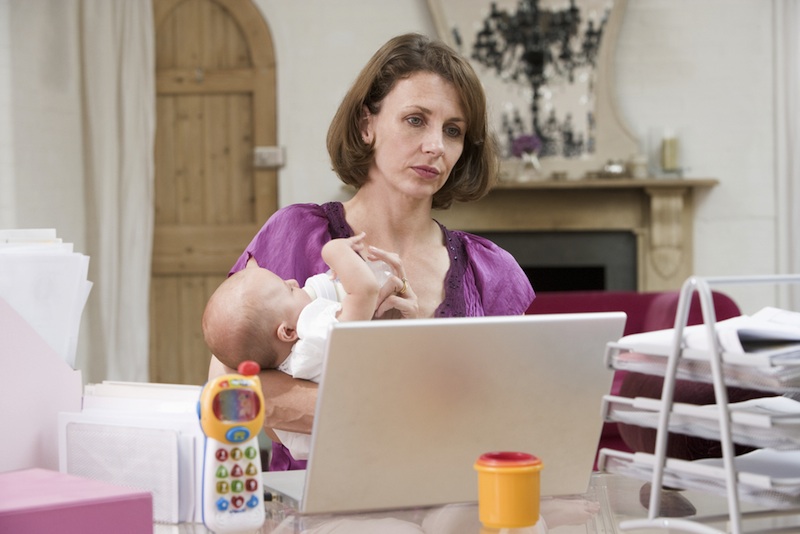Moms Multitask More Than Dads, Enjoy it Less

The stereotype of the busy working mom divvying up her energy between kids, husband and housework is at least partially true, according to new research that finds that not only do mothers multitask more than fathers, they're less happy doing so.
The study, published today (Dec. 1) in the journal American Sociological Review, finds that working mothers spend about 10 hours a week more multitasking than do working fathers. While dads are more engaged than ever in home life, the research reveals that moms still shoulder a heavier burden, said study researcher Barbara Schneider, a sociologist at Michigan State University.
"Moms today who work full time basically have to worry about working full time and being a mom and a spouse," Schneider said. "It makes it very difficult."
Juggling responsibilities
Multitasking may feel productive, but psychological research suggests our brains aren't at their best when divided between two or more tasks. One 2010 study published in the journal Science found that the brain can juggle two tasks at once, but adding a third is a recipe for disaster. Even practiced multitaskers struggle with the overload. According to research by Stanford University professor Clifford Nass, the people who multitask the most are the worst at it.
But for modern families, multitasking is a way of life. Schneider and her colleagues wanted to know how much time moms and dads spend doing two or more things at once, and just as important, how they felt about it.
As part of a large 1999-2000 study of mostly middle-class families called the 500 Family Survey, researchers asked parents to wear pre-programmed wristwatches that would beep eight times each day. When the participants heard the beep, they stopped everything to record in a diary what they were doing, whom they were with, and their emotions at the moment. This method, called "experience sampling," was developed by Hungarian psychologist Mihaly Csikszentmihalyi.
Sign up for the Live Science daily newsletter now
Get the world’s most fascinating discoveries delivered straight to your inbox.
"What we're really learning is not only how people are spending their time, but how they're feeling about it at a very deep and personal level," Schneider said.
With a total sample of 16,878 diary entries of 368 moms and 9,482 entries of 241 dads, the researchers found that multitasking is very common. Fathers multitask for more than a third of their waking hours, while mothers multitask for two-fifths of their waking lives.
Paid work puts a lot of multitasking burden on both moms and dads, with work-related multitasking making up 36 percent of multitasking episodes for dads and 23.4 percent of multitasking episodes for moms. At home, however, mothers are more likely than fathers to engage in two housework activities or two child care-related activities at the same time, the study found. Housework and child care combos accounted for 10 percent of moms' multitasking time and only 4.4 percent for dads.
Modern family
Though moms piled on more multitasking at home than dads, they were also less cheery about it. They reported a lower sense of well-being when multitasking than did multitasking dads, Schneider said. Moms reported more negative emotions and more stress when they multitasked at home compared with when they did a single task, while fathers did not show this increase in negative emotions.
"Basically, that's telling you that when dads are at home and they multitask, they pretty much are thinking it's a good thing," Schneider said. "This is less so in the case of moms."
Some of the emotional discrepancy may have to do with who juggles what tasks. The study found that for working moms, 52.7 percent of multitasking episodes at home were housework-related, compared with 42.2 percent for working dads. Likewise, 35.5 percent of home multitasking for moms involves child care, compared with 27.9 percent for dads.
The results highlight the stress that middle-class families face in the modern work force, Schneider said.
"We have 21st-century workers, and it's very difficult," she said. "The problem is that workplaces are really 20th century. We still have pretty much the same kind of work week, the same work expectations. … We've got to think about more flexible work arrangements."
You can follow LiveScience senior writer Stephanie Pappas on Twitter @sipappas. Follow LiveScience for the latest in science news and discoveries on Twitter @livescience and on Facebook.

Stephanie Pappas is a contributing writer for Live Science, covering topics ranging from geoscience to archaeology to the human brain and behavior. She was previously a senior writer for Live Science but is now a freelancer based in Denver, Colorado, and regularly contributes to Scientific American and The Monitor, the monthly magazine of the American Psychological Association. Stephanie received a bachelor's degree in psychology from the University of South Carolina and a graduate certificate in science communication from the University of California, Santa Cruz.









